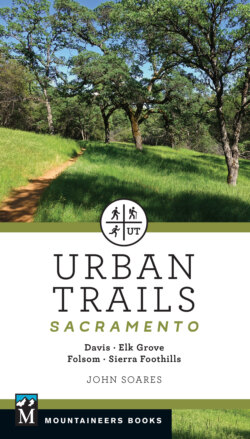Читать книгу Urban Trails: Sacramento - John Soares - Страница 12
На сайте Литреса книга снята с продажи.
THE DESTINATIONS
ОглавлениеThis book covers thirty-five trails and trail systems in and around Greater Sacramento, including downtown, the suburbs, the Sacramento Valley, and the nearby Sierra Nevada foothills, including Auburn State Recreation Area.
Each route description begins with the trail name or park name, followed by a block of information that details the following:
Distance. Here you will find roundtrip mileage or a total mileage of trails.
Elevation gain. The total amount of elevation you’ll climb over the course of the route is given in feet. This number takes into account all the ups and downs, not just the difference between the starting point and the high point.
High point. The highest point of elevation you reach during the journey is also provided in feet.
Difficulty. The five categories of difficulty are easy, easy to moderate, moderate, moderate to challenging, and challenging. A subjective measurement, the difficulty level is an estimate of the total effort required to complete the route. It primarily reflects total distance and elevation gain but can also take into account short, steep stretches of rough, difficult-to-negotiate trail. Always assess the abilities of the least able person in your group when picking a hike.
Fitness. This category indicates whether the trail is best suited to walkers, hikers, or runners. Paved paths that are mostly level will appeal to walkers and runners and to people with mobility issues or with small children and perhaps a baby stroller. Trails designated for hikers have narrower, unpaved paths that typically have more elevation gain. Of course, a dedicated hiker can walk a level, paved path, and a hard-core runner can run on steep dirt trails.
Lupine and lichen in the Sierra foothills
Family-friendly. This field indicates the suitability of a route for children twelve years old and younger. It may also mention fun attractions for kids, any specific hazards such as cliffs, and multiuse trails where bike use is common.
Dog-friendly. This description lets you know if your pooch is welcome and under what rules (on-leash only, under strict voice command, etc.). Always have a leash with you.
Bike-friendly. Here you will find whether bikes are allowed, regulations on bike use, and any information relevant to biking on trails and paths.
Amenities. Park, recreation area, and other trail amenities can include features such as restrooms, picnic tables, drinking fountains, playgrounds, interpretive nature panels, and campgrounds, among others.
Contact/map. In this field, you will find the name of the route’s managing agency, which is the main contact for current trail conditions and further information that could affect your access to and enjoyment of the trails. Most agencies offer a downloadable map (often high quality); if no map is available online, it will be indicated here. See Trail and Park Management Agencies in the Resources section for website addresses and phone numbers.
GPS. The GPS coordinates for the main trailhead appear here in degrees and decimal minutes (based on WGS84 datum).
More key info. Here you’ll find information about whether a trail or park charges a fee or requires a permit, as well as hours of operation, seasonal closures, and anything else relevant to your ability to access and enjoy the trails.
GETTING THERE. Driving: This section provides directions to the trailhead from the nearest town, freeway exit, or major road intersection and gives details on parking. (Note: There are often multiple ways to access trailheads, especially in Sacramento and the greater urban area, depending on where you are driving from.) Transit: If public transportation serves the trailhead, you’ll find the agency and line number here as well as the bus stop closest to the trailhead.
HIKE OVERVIEW. The overview describes key features of the trail or park, including notable geographic details and history. This brief description can help you choose the best outing for you and your companions.
GET MOVING. This section, the longest of each destination, provides specific guidance on where to go on the trails and how to get there along with descriptions of what you might experience along the way.
GO FARTHER. Finally I offer suggestions, where applicable, for extending your hike, walk, or run on other paths within the park system or nearby.
